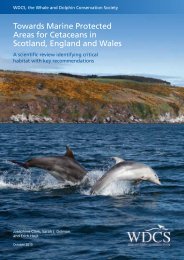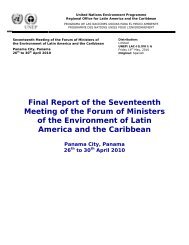Sea Turtle Recovery Action Plan for St. Kitts and Nevis - WIDECAST
Sea Turtle Recovery Action Plan for St. Kitts and Nevis - WIDECAST
Sea Turtle Recovery Action Plan for St. Kitts and Nevis - WIDECAST
Create successful ePaper yourself
Turn your PDF publications into a flip-book with our unique Google optimized e-Paper software.
<strong>St</strong>. <strong>Kitts</strong> <strong>and</strong> <strong>Nevis</strong> <strong>Sea</strong> <strong>Turtle</strong>s…National Park Society. The Conservation Commission acts as an advisory commission to theMinister with functions of managing <strong>and</strong> controlling activities concerning beaches, nationalparks <strong>and</strong> protected areas. Management plans are to be prepared <strong>for</strong> all protected areas by theConservation Commission.It is a recommendation of this <strong>Recovery</strong> <strong>Action</strong> <strong>Plan</strong> that all relevant coastal zoneauthorities -- Ministers, development <strong>and</strong> advisory boards, the Conservation Commission -- worktogether with residents <strong>and</strong> non-government groups in full support of declaring <strong>and</strong>administering protected areas <strong>for</strong> the benefit of endangered sea turtles. The legislation to declareprotected areas exists in the NCEPA, it has only to be fully realised <strong>and</strong> implemented. Inaddition to the federal legislation, the <strong>Nevis</strong> Isl<strong>and</strong> Administration may be able to declareprotected areas under the auspices of <strong>Nevis</strong> planning legislation; this option should be explored.4.122 Develop regulatory guidelinesIn order <strong>for</strong> management planning to be effective, a regulatory framework is needed. TheSoutheast Peninsula L<strong>and</strong> Development <strong>and</strong> Conservation Board has already developed detailedguidelines <strong>for</strong> development of the peninsula, as well as a strategy <strong>for</strong> managing l<strong>and</strong> use(Ministry of Development, 1989a,b). Copies of these guidelines are provided to prospectivedevelopers <strong>and</strong> established protocols must be incorporated into all development <strong>and</strong> constructionplans. Many of the guidelines, such as <strong>for</strong> construction setbacks, solid waste disposal <strong>and</strong>l<strong>and</strong>scaping, are identical to those generally proposed to safeguard sea turtle nesting areas. It is arecommendation of this <strong>Recovery</strong> <strong>Action</strong> <strong>Plan</strong> that equivalent guidelines be adopted <strong>for</strong> alldevelopment in <strong>St</strong>. <strong>Kitts</strong> <strong>and</strong> <strong>Nevis</strong>; further, that the guidelines be adhered to by developers <strong>and</strong>that the Board not waver or deviate from what has been established.Regulations most important to the conservation of turtles fall into two categories: thosepertaining to s<strong>and</strong>y beaches (egg-laying) <strong>and</strong> those pertaining to coral reefs <strong>and</strong> sea grass (food<strong>and</strong> shelter). Guidelines currently under development <strong>for</strong> the Newcastle Marine Reserve in<strong>Nevis</strong> are a useful model <strong>for</strong> marine protected areas. In a Beach Management <strong>Plan</strong> submitted tothe SEP L<strong>and</strong> Development <strong>and</strong> Conservation Board, Orme (1989) made several recommendations"to preserve the valuable beach resources of the Southeast Peninsula <strong>and</strong> to manage theseso as to minimize the negative impacts of development." Eckert (1989) made similar recommendationsto the Board in a <strong>Sea</strong> <strong>Turtle</strong> Management <strong>Plan</strong> designed to conserve the peninsula's seaturtles in view of impending development. The following points are based on Orme (1989) <strong>and</strong>Eckert (1989). Topics are discussed in further depth in the section(s) noted in parentheses.1) S<strong>and</strong> mining: No mining of beach s<strong>and</strong> should be permitted under any circumstances(section 4.131). Beach s<strong>and</strong> is a finite resource that reportedly is not being replenished at thepresent time at a rate commensurate with past deposition; thus, beach mining implies beach loss.In addition, the persistent removal of beach s<strong>and</strong> disrupts stabilising vegetation <strong>and</strong> exacerbateserosion. The resulting pits not only invite injury to both humans <strong>and</strong> livestock, but theyaccumulate water <strong>and</strong> serve as breeding areas <strong>for</strong> mosquitoes <strong>and</strong> other unwanted insects. Orme(1989) also recommends that no mining of s<strong>and</strong> be permitted in the offshore or nearshore zonesas this material is important to beach maintenance. Orme (1989) <strong>and</strong> Cambers (1988) bothindicate ghauts (ravines) <strong>and</strong> interior sites where mining would be acceptable.Page 33

















